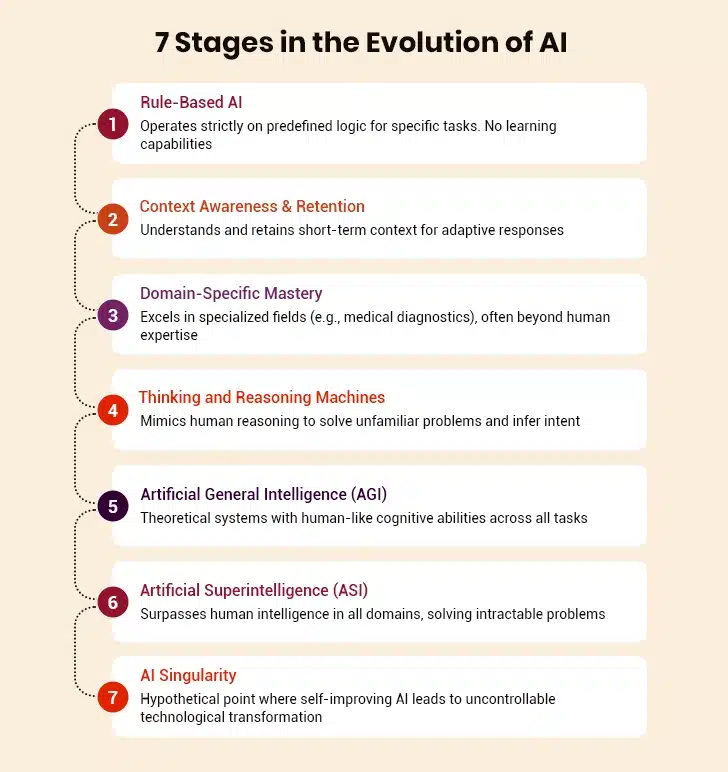Most businesses recognize the strategic significance of AI. Yet only a small fraction has moved beyond AI pilots. This gap reveals a fundamental truth: technical expertise alone isn’t enough to succeed in the AI domain. Strong leadership and executive vision are critical.
The potential rewards of getting AI leadership right are substantial. Companies that make strategic AI investments in high-priority areas see stronger revenue growth and improved stakeholder returns. They scale AI effectively to create new income streams. Yet most executives struggle to drive AI projects to fruition or generate meaningful ROI from such initiatives.
This blog explores why executive vision is required to drive AI development. It also talks about how leadership changes experimental AI initiatives into strategic advantages, and what business leaders need to know to bridge the implementation gap.
Table of Contents
Redefining the Strategy Stack: AI at the Helm
Redefining the Strategy Stack: AI at the Helm
“Artificial intelligence will reach human levels by around 2029. Follow that out further to, say, 2045, we will have multiplied the intelligence, the human biological machine intelligence of our civilization a billion-fold.”
-Ray Kurzweil, American computer scientist
Today, AI has moved beyond being just a support tool. It now drives the core business strategy. Yet only 7% of organizations use AI in their strategy or financial planning. That’s a vast, untapped opportunity for a competitive advantage.
1. How AI Changes Long-Term Planning and Decision-Making
AI has changed how companies plan their strategies. It enables data-driven decision-making at speed and scale. Through advanced AI systems that continuously process real-time data, businesses can detect market shifts as they happen. They don’t need to wait for quarterly reviews or annual planning cycles. Strategy has thus evolved from a static plan into a dynamic framework that adapts as the business environment changes.
AI also supports better decision-making by removing human bias from the equation. It provides unbiased predictions based on systematic data analysis. The technology thus creates a foundation that assists with informed strategic planning and optimal resource allocation.
2. Evolving From Reactive Data Usage to Predictive and Prescriptive Intelligence
Strategic intelligence has grown in stages:
- Descriptive Analytics: Examines what happened in the past
- Diagnostic Analytics: Determines why it happened
- Predictive Analytics: Forecasts what will happen
- Prescriptive Analytics: Recommends the best course of action
Today, companies can take action instead of just reacting to changes in the market. Predictive analytics help forecast trends. Prescriptive analytics goes further by suggesting specific choices. As a result, organizations can actively shape business outcomes.
The global market for predictive and prescriptive analytics is projected to grow at a CAGR of 24% between 2025 and 2030. This clearly shows that modern businesses have recognized their strategic value.
3. Case in Point: AI-Driven Pivots in Top Enterprises
Many leading enterprises showcase the power of an AI-driven strategy. To cite an example, Amazon’s AI-based predictive model analyzes live data from many sources, including:
- Sales Patterns
- Economic Indicators
- Social Media Trends
- Weather Forecasts
This way, demand changes can be anticipated accurately. The model proves crucial during emergencies when inventory levels can be adjusted to handle the surge in demand for essential goods.
Likewise, JPMorgan Chase uses AI to manage risk better across many areas. Their AI models check borrowers’ creditworthiness through traditional metrics and other data like spending habits and behavior patterns. These systems run stress tests too. They simulate different economic scenarios to see how portfolios hold up under adverse conditions.
Such AI-driven pivots aren’t merely operational improvements. They represent a completely new way of creating business value.
AI Agents Explained: How Knowledge-Based AI is Revolutionizing Decision-Making
The Rise of Autonomous Strategy Engines
Autonomous AI stands at the forefront of business intelligence. Modern AI systems generate and optimize strategies with minimal human intervention. These systems represent a shift from traditional analytics, as they learn, adapt, and operate across multiple business domains.
I. Engineering Intelligence into Enterprise Systems
Self-learning algorithms form the core of intelligent enterprise systems. These algorithms spot patterns, generate insights, and make decisions independently. Intelligent enterprise systems develop their own understanding of business contexts through continuous learning. They differ from conventional software that follows predetermined rules.
Enterprise intelligence requires the integration of multiple AI capabilities. Natural language processing, machine learning, computer vision, and complex reasoning work together to create cohesive systems. These systems understand business goals and independently determine the best path forward. No need for constant human input. Put another way, AI-based systems have evolved from simple tools into partners that collaborate with business leaders.
II. Role of AI in Scenario Planning, Demand Forecasting, and M&A Analysis
Autonomous AI models prove useful in scenario planning. These systems develop multiple future scenarios based on several interconnected variables. This allows business leaders to explore a broad range of possibilities. They can study uncertainties that could influence the future and devise more robust strategies.
AI-powered engines also help with demand forecasting. Here, traditional time-series data is integrated with unstructured data from social media, news feeds, and economic indicators to predict demand. This approach reduces forecast errors considerably when compared to traditional methods.
AI has changed how M&A due diligence works. AI-ML models analyze massive datasets across several critical areas: financial records, legal documents, and cultural fit. This helps identify potential issues and inconsistencies that conventional analysis might overlook.
III. Implications for Boardrooms and Leadership Teams
Boardrooms see a fundamental shift in governance as AI systems become more capable. Directors must understand AI well enough to supervise systems making high-stakes decisions independently.
Leadership teams must redefine their roles as AI takes over routine strategic work. Executives can now focus on areas where humans excel—ethics, creative thinking, and building relationships. They spend less time gathering and analyzing data.
This transition has created new challenges. When autonomous systems make recommendations, the question of responsibility becomes complex.
Understanding who bears responsibility for outcomes requires governance frameworks that balance innovation with oversight.
Architecting the AI Software Backbone
Building effective AI systems goes beyond algorithms and data. It demands a solid architectural foundation. Smart organizations are rebuilding their technical infrastructure to support advanced AI capabilities.
1. The Shift to Composable, API-Driven AI Systems
Flexible, composable architectures are replacing the monolithic applications that once ruled enterprise IT. Modern systems now use specialized components connected through APIs. This setup lets organizations build custom AI capabilities from reusable blocks.
This architectural approach brings several benefits to AI development. Teams can quickly modify or replace individual components without affecting the whole system. The API-driven designs also make sharing work between technical and business teams easier.
Organizations can adopt AI capabilities incrementally with composable architectures. They can begin with specific use cases and expand their AI footprint gradually. No need to implement everything at once. This method reduces risk and speeds up value delivery.
2. AI, Cloud, and Data Mesh as the New Enterprise Foundation
The most effective AI architectures combine three critical elements. Cloud computing provides scalable resources and managed services that AI workloads need. Data mesh architectures let domain experts own and manage their data while maintaining governance standards. AI systems then use information from this infrastructure to generate insights and automate decision-making.
This integrated approach solves many challenges in enterprise AI development:
- Scale: Cloud platforms offer unlimited computational resources for training and deploying AI models.
- Faster Access to Data: Data mesh architectures transfer data control to domain specialists. This ensures swift access to data.
- Improved Governance: Centralized policies ensure consistent security and compliance across distributed systems.
- Flexibility: Components of an AI system can evolve independently as business needs change.
Needless to say, executives leading AI initiatives must understand this architectural foundation. The technical choices they make today will shape their organization’s AI capabilities.
From Cost Centers to Intelligent Profit Drivers
AI development is changing traditional cost centers into strategic profit engines. Modern organizations don’t view operational functions as expenses. They see them as opportunities for value creation through intelligent systems.
I. Turning Operations into AI-Enhanced Growth Levers
An organization’s core operations become strategic assets when enhanced with AI capabilities. Embedding intelligence into business processes unlocks new sources of value beyond cost reduction. For example, customer support systems augmented with AI can anticipate needs, personalize interactions, and identify growth opportunities. Likewise, product development moves faster when AI tools analyze usage patterns, identify unmet needs, and test concepts with virtual customers.
II. Intelligent Automation Beyond RPA: Cognitive, Contextual, and Self-Optimizing Systems
Conventional robotic process automation (RPA) merely replicates human actions. It does not understand context or adapt to new situations. Modern AI systems differ significantly: they understand unstructured data. They learn from experience and make increasingly sophisticated decisions. These advanced systems gain an understanding of the context and make decisions or predictions within a specific situation. They also improve their performance over time without human help.
III. Strategic AI Use Cases by Function: Finance, Supply Chain, and HR
Each business function offers unique opportunities for AI-driven change. Finance teams use AI to spot unusual transactions, predict cash flow, and create forecasts that adjust to market changes. Supply chain teams optimize inventory, schedule maintenance, and use smart systems that negotiate with suppliers based on market conditions. HR departments use AI to analyze talent and plan succession, which ensures leadership continuity.
These business functions once struggled to contain costs. Today, they drive competitive advantage through improved intelligence and foresight. Companies that succeed in this shift reduce costs, boost revenue, and improve their market position.
The Ethical Core of Strategic AI
Ethics form the basis of successful AI development. Research shows that 85% of users are likely to trust businesses that use AI ethically. Making AI ethical isn’t just about following rules; it is what gives companies an edge.
1. Building Trust, Explainability, and Governance into AI Decision Systems
Trustworthy AI systems need transparency by design, not as an afterthought. Organizations must build explainability mechanisms that make complex algorithms understandable for non-technical users. Many enterprises are implementing “glass box” approaches where AI decision pathways can be audited and understood.
Governance structures need to balance progress with responsibility. Companies should set up AI ethics teams with people from diverse backgrounds. Regular audits of algorithms and clear protocols for AI-driven decisions help too. These steps keep AI systems fair and in line with organizational values.
2. Frameworks to Ensure Alignment with Business and Social Values
Ethical AI frameworks provide structured approaches to ensure AI systems align with business goals and societal values. Successful frameworks address several key dimensions:
- Fairness and bias mitigation
- Privacy and data protection
- Transparency and explainability
- Accountability and governance
- Social and environmental impact
These frameworks become more important with time as AI systems gain autonomy in decision-making.
Ethical AI does a lot more than just risk mitigation. It creates value. Companies that use AI responsibly build better relationships with customers, workers, and regulators.
How Model Context Protocol in AI Ensures Long-Term Business Success
Winning the Future: A C-Suite AI Readiness Framework
Executive leadership remains the defining factor in successful AI initiatives. Organizations must develop structured frameworks to evaluate and improve their AI capabilities.
1. How to Assess Your Enterprise’s AI Maturity Beyond Tools and Models
Evaluating AI maturity requires business leaders to look past technology stacks to organizational readiness. Effective assessment frameworks should answer several key questions, including:
- Is the organization’s existing tech infrastructure capable of supporting large-scale AI projects?
- Do they have adequate technical expertise and domain knowledge to implement AI initiatives?
- Have their teams identified specific areas within the organization where AI can add significant value?
- What data assets does the organization have? Is this data accessible, reliable, and properly formatted?
- How will the integration of AI systems affect existing workflows and the workforce?
- Do leadership teams show openness to algorithm-informed decisions?
- Is the organization prepared to tackle the ethical issues of AI-based systems?
2. From Data Engineers to AI Strategists: New Roles to Achieve Success with AI
Effective AI development requires businesses to have the right individuals on board. Companies should go beyond just hiring tech experts and aim to include people with varied skills, such as:
- Domain Experts: These experts communicate with real users of an AI system and offer feedback on improving performance.
- AI Strategist: They work with technology leaders to plan and guide AI development and implementation. They help identify where AI could improve productivity, enhance decision-making, or boost customer service.
- AI Governance Specialist: These experts focus on creating policies and frameworks that ensure responsible AI use. They help build AI systems that stay ethical and follow compliance guidelines.
- Chief AI Officer: The Chief AI Officer is the prime decision-maker for all AI projects. They spot opportunities to use AI in ways that are both profitable and sustainable. They also articulate the business benefits of AI to key stakeholders.
Moving from Experiments to Endgame
Success with AI demands more than technological expertise. Effective AI development requires strategic vision, architectural foundations, ethical frameworks, and organizational readiness. To shift from reactive data usage to predictive and prescriptive intelligence, leaders must understand how advanced autonomous AI systems can help with planning and analysis.
The gap between AI experimentation and strategic implementation brings many challenges. Even so, organizations with clear vision and a well-thought-out plan can turn AI from a technological novelty into a competitive advantage. Businesses that spot this opportunity and act decisively will lead the change instead of merely reacting to it.







